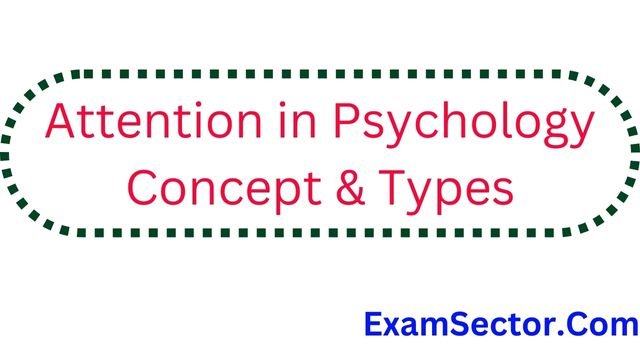Attention in Psychology Concept & Types
Attention in Psychology
- Many objects present in the room where you are reading can work as stimuli for you such as chair, table, fan, books etc. But you cannot pay attention to all these stimuli at once. Your attention is on the page of the book that you are reading. It means that we do not respond to all stimuli. We select some stimuli as per our needs and desires and respond only to the selected ones. In psychology, this kind of selection process is termed as attention.
- It is important to note that attention depends, apart from selection, on some other factors also such as alertness, concentration and search. Alertness refers to the readiness by which a person faces the stimuli. You might have seen the participants of the run race in your school standing on the starting line waiting for whistle blow. Concentration refers to focusing on certain stimuli for the better awareness and keeping other objects out of sight. For example, students concentrate on teacher’s lecture in the class and do not pay attention to other noise coming from outside the class. Search is an state where observer focuses on a particular object from a set of different objects. For example, when you go to school to bring your younger brother/sister to home then you look for them in the crowd of so many children. To do this, we have to put some effort. We can attend to a limited set of stimuli at one time. The question remains is that which stimuli will be selected out of so many . Psychologists have identified different factors that can affect the selection of of so many. Psychologists have stimuli during the process of attention.
Factors affecting attention
- Many factors affect attention. These factors are usually related to stimulus characteristics and person-related characteristics. These factors are usually classified as external and internal factors. External factors are related to stimulus characteristics such as type of stimulus; visual stimuli tend to attract person’s attention in comparison to auditory stimuli. The posters of cinema are more attended than its sound. If there is a change in stimuli before a person, it catches attention. For e.g. if a running fan in the room suddenly stops running, it will get attention. Novel stimuli also get attention such as a new dress that you wear. If a student contrary to routine wears a dhoti-kurta in school, then other students will give attention to that student. Similarly, other stimulus related factors such as stimulus’s big size, more intensity, repetitiveness, differentiation from other stimuli also get person’s attention.”
- Internal factors are person’s individual factors. When we are hungry, we attend even to mildest smell of food. A student who has to appear in an examination is more attentive to teacher’s lecture than the student who is not appearing in any examination. The person who has interest in cricket will pay more attention to news related to cricket. If you are waiting for somebody at your home, you will attend to opening of the main gate even when the television is being watched in loud noise. Objects or events which are of interest to a person are more readily attended. Meaningful stimuli get more attention. For example a Hindi knowing person will attend to messages in Hindi amongst messages displayed on a bus stand in Hindi, English and Regional languages. Previous training also has impact on attention. A doctor can readily identify a patient because he has been specially trained for identifying symptoms of diseases and its treatment.
- In this way, we find that both stimulus related external factors and person related internal factors play an important role as determinants of attention.
Latest Post of Psychology :– Click Here
Attention in Psychology FAQ –
1. Which of the following is not an external sensory organ?
A. Nose
B. Skin
C. Ears
D. Kinesthetic
2. Who is not a Gestalt Psychologist?
A. Kohler
B. Koffka
C. Watson
D. Wertheimer
3. The initial information received through body’s sensory organs is known as:
A. perception
B. sensation
C. cognition
D. adaptation
4. ‘We have a tendency to fill in the gaps in the stimulus. Which principle of perceptual organization is this?
A. continuity
B. proximity
C. closure
D. similarity
